
aquatic therapy exercises pdf
Aquatic therapy exercises‚ detailed in various PDF guides‚ offer a low-impact‚ effective way to enhance strength‚ flexibility‚ and cardiovascular health. Techniques like Ai Chi and aquatic aerobic exercises are highlighted as beneficial for rehabilitation‚ chronic pain management‚ and improving balance‚ making them ideal for diverse groups‚ including seniors and athletes.
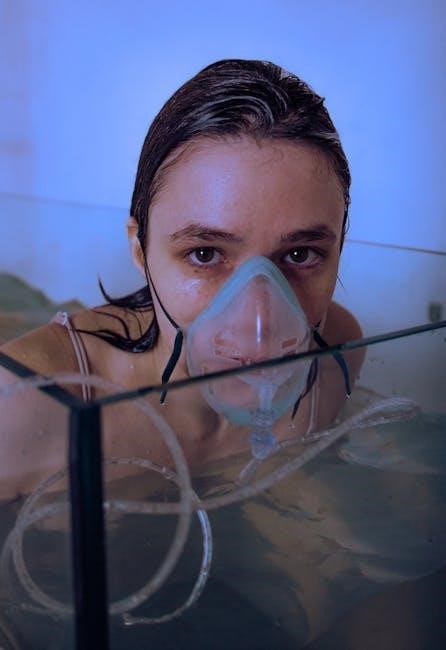
1.1 Definition and Overview
Aquatic therapy‚ as outlined in various PDF guides‚ refers to therapeutic exercises performed in water‚ leveraging its buoyancy‚ viscosity‚ and hydrostatic pressure. These exercises are designed to enhance physical rehabilitation‚ improve mobility‚ and strengthen muscles without excessive joint stress. Aquatic therapy is widely used for injury recovery‚ chronic pain management‚ and overall wellness. It combines aerobic‚ strength‚ and flexibility exercises tailored to individual needs. The water environment reduces impact on joints‚ making it ideal for diverse populations‚ including athletes‚ seniors‚ and individuals with chronic conditions. This form of therapy promotes relaxation‚ improves balance‚ and enhances cardiovascular health‚ offering a holistic approach to physical fitness and rehabilitation.
1.2 Benefits of Aquatic Therapy
Aquatic therapy offers numerous benefits‚ including reduced joint stress‚ improved circulation‚ and enhanced muscle relaxation. The buoyancy of water minimizes impact‚ making it ideal for individuals with joint pain or chronic conditions. It also improves cardiovascular health‚ strengthens muscles‚ and increases flexibility. Aquatic therapy promotes better balance and coordination while providing a low-impact environment for rehabilitation. Additionally‚ the hydrostatic pressure of water aids in reducing inflammation and swelling. These benefits make aquatic therapy a versatile and effective option for various populations‚ from athletes to seniors‚ and those recovering from injuries or managing chronic pain. Its holistic approach combines physical and mental relaxation‚ enhancing overall well-being.
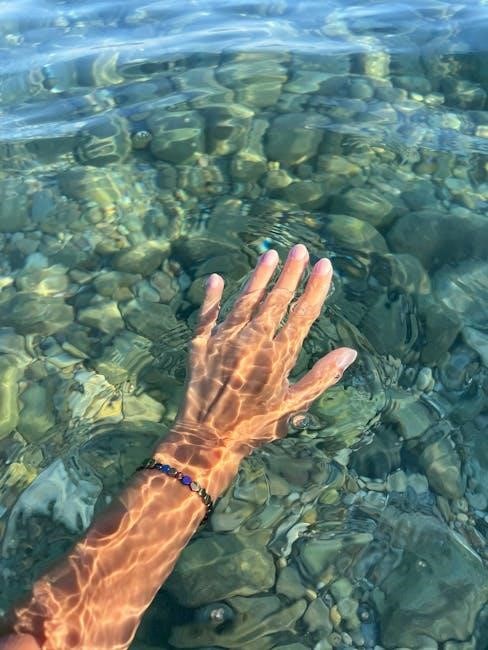
History and Origins of Aquatic Therapy
Aquatic therapy traces its roots to ancient civilizations‚ with early forms of water-based healing practiced in Egypt‚ Rome‚ and China. Its evolution into modern practice began in the 19th century‚ incorporating scientific principles for rehabilitation and exercise.
2.1 Early Forms of Water-Based Therapy
Ancient civilizations recognized water’s therapeutic potential‚ using it for healing and relaxation. Egyptians employed water for physical therapy around 2500 BCE‚ while Greeks and Romans utilized thermal baths for wellness. In Asia‚ traditional Chinese medicine incorporated water therapy for balancing energies. These early practices laid the groundwork for modern aquatic therapy‚ emphasizing water’s buoyancy and hydrostatic properties to aid recovery and improve physical function. Early techniques included immersion‚ temperature variations‚ and gentle movements‚ setting the stage for today’s structured exercises. These historical methods highlight water’s enduring role in therapeutic practices‚ evolving over millennia into diverse‚ specialized approaches.
2.2 Evolution into Modern Practice
Aquatic therapy has evolved significantly from its traditional roots‚ now incorporating evidence-based practices tailored to individual needs. Modern techniques like Ai Chi blend mind-body exercises with water’s therapeutic properties‚ while the Bad Ragaz Ring Method focuses on precise movements for strength and flexibility. Advances in understanding water’s buoyancy‚ viscosity‚ and hydrostatic pressure have enabled therapists to design specialized exercises for rehabilitation‚ chronic pain management‚ and sports performance enhancement. PDF guides detail structured routines‚ emphasizing progressive resistance and functional movements. This evolution ensures aquatic therapy remains a versatile and effective modality‚ addressing diverse populations‚ from athletes to seniors‚ with adaptable and scientifically supported methods. Its growth reflects ongoing research and clinical application‚ solidifying its place in contemporary rehabilitation practices.
Types of Aquatic Therapy Exercises
Aquatic therapy exercises include aerobic workouts‚ strength training‚ flexibility routines‚ and balance activities‚ tailored to enhance physical fitness and aid in rehabilitation‚ as detailed in PDF guides.
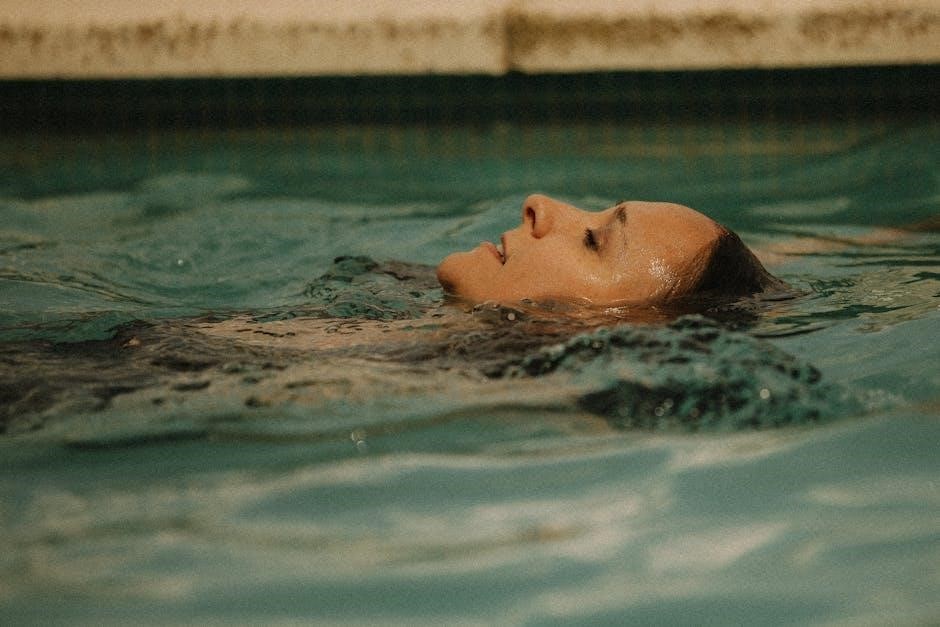
3.1 Aerobic Exercises in Water
Aquatic aerobic exercises are dynamic movements performed in water‚ designed to elevate heart rate and improve cardiovascular fitness. These exercises‚ such as water jogging‚ cycling‚ and high-intensity interval training (HIIT)‚ leverage water’s resistance to enhance calorie burn and muscular endurance. They are low-impact‚ reducing joint stress‚ making them suitable for individuals with arthritis or injuries. Many PDF guides highlight the benefits of aquatic aerobics‚ including improved circulation and increased stamina. These workouts often incorporate equipment like water noodles or resistance bands to intensify sessions. Regular participation can lead to enhanced overall physical fitness and better mental well-being‚ as detailed in various aquatic therapy resources.
3.2 Strength Training Exercises
Aquatic strength training exercises utilize water’s resistance‚ buoyancy‚ and viscosity to build muscular endurance and power. Techniques include working against water flow‚ using pool equipment like dumbbells or resistance bands‚ and performing controlled movements. These exercises target major muscle groups‚ enhancing strength without excessive joint strain. For example‚ leg presses against the pool wall or arm lifts with resistance bands are common practices. The water’s natural resistance provides an effective workout‚ adaptable to individual fitness levels. Many PDF guides emphasize the benefits of aquatic strength training for rehabilitation‚ injury recovery‚ and overall muscle toning‚ making it suitable for both therapeutic and general fitness purposes.
3.3 Flexibility and Stretching Exercises
Aquatic flexibility and stretching exercises leverage water’s buoyancy to enhance range of motion and reduce stiffness. Techniques like calf stretches‚ hamstring stretches‚ and shoulder rotations are commonly practiced. The water’s support allows for deeper stretches without joint strain‚ making it ideal for individuals with limited mobility. Controlled movements‚ such as leg swings and arm circles‚ improve flexibility while minimizing discomfort. Many PDF guides highlight the benefits of aquatic stretching for chronic pain management and post-injury rehabilitation. These exercises promote relaxation and muscle elongation‚ making them essential for overall mobility and recovery. Regular aquatic stretching can significantly improve joint health and reduce muscle tension‚ enhancing quality of life for participants.
3.4 Balance and Coordination Exercises
Aquatic therapy emphasizes balance and coordination exercises to enhance stability and motor control. Standing on one leg‚ heel-to-toe walking‚ and reaching exercises are common practices. The water’s buoyancy provides support‚ reducing the risk of injury while challenging balance. Techniques like single-leg stance with arm movements or using flotation devices for stability are frequently recommended in PDF guides. These exercises strengthen core muscles and improve posture. Water’s resistance helps refine coordination‚ making it ideal for rehabilitation and senior therapy. Regular practice enhances overall balance‚ reducing the risk of falls and improving daily functional movements. Aquatic balance exercises are versatile‚ catering to diverse fitness levels and conditions‚ ensuring safe and effective progression.
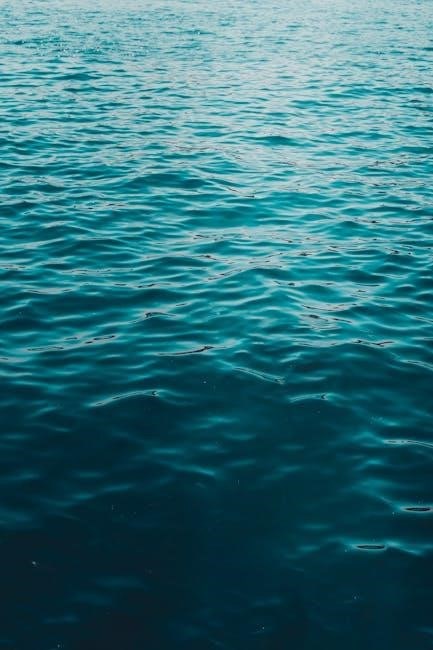
Techniques Used in Aquatic Therapy
Aquatic therapy incorporates techniques like Ai Chi and the Bad Ragaz Ring Method‚ blending mental relaxation with physical movement. These methods utilize water’s buoyancy and resistance for therapeutic benefits.
4.1 Ai Chi
Ai Chi is a water-based exercise program that combines elements of Tai Chi and Qigong‚ emphasizing slow‚ flowing movements to promote relaxation and balance. It is performed in warm water‚ typically shoulder-deep‚ allowing participants to move comfortably with minimal joint stress. The program integrates deep breathing techniques with controlled movements‚ enhancing both physical and mental well-being. Ai Chi is particularly beneficial for improving flexibility‚ strength‚ and cardiovascular health while reducing stress and anxiety. It is widely recommended for individuals with chronic pain‚ arthritis‚ and mobility challenges‚ as it provides a gentle yet effective form of therapy in an aquatic environment.
4.2 Bad Ragaz Ring Method
The Bad Ragaz Ring Method is a specialized aquatic therapy technique developed by a physical therapist in the 1950s. It focuses on using water’s buoyancy and resistance to enhance spinal stabilization‚ strength‚ and flexibility. This method employs flotation devices‚ such as rings‚ to support the body during exercises‚ allowing patients to perform movements with reduced strain. It is particularly effective for individuals with neurological or spinal injuries‚ as it promotes controlled movements and muscle activation. The technique emphasizes proper alignment and breathing‚ making it a valuable tool in rehabilitation programs. Its structured approach ensures patients can progress safely‚ achieving improved mobility and strength in an aquatic environment.
Applications of Aquatic Therapy
Aquatic therapy is widely applied in rehabilitation‚ chronic pain management‚ sports performance enhancement‚ and senior fitness. It aids in injury recovery‚ improves mobility‚ and enhances overall well-being for diverse populations.
5.1 Rehabilitation for Injuries
Aquatic therapy plays a crucial role in injury rehabilitation by providing a low-impact environment that minimizes stress on joints. Water’s buoyancy allows for partial weight-bearing exercises‚ which are especially beneficial for individuals recovering from fractures‚ sprains‚ or surgeries. The viscosity of water offers resistance‚ helping to strengthen muscles without overloading injured areas. Hydrostatic pressure improves circulation and reduces swelling‚ promoting faster healing. Patients can perform controlled movements‚ enhancing range of motion and flexibility. Aquatic therapy is particularly effective for knee and hip injuries‚ as it facilitates early mobilization and restores functional movement patterns. This approach is often combined with land-based therapy for comprehensive recovery.
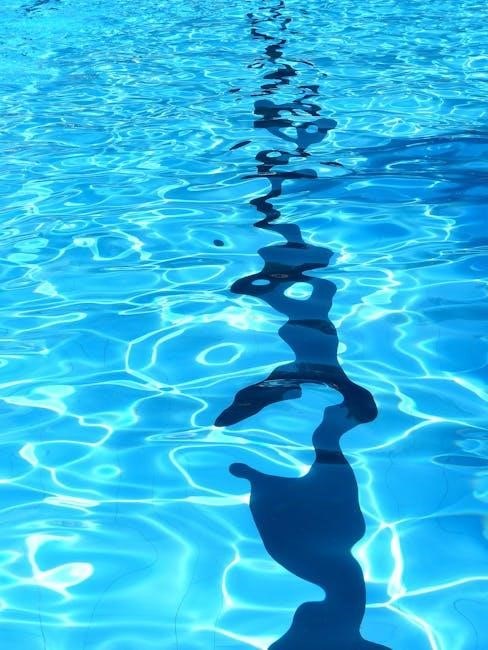
5.2 Chronic Pain Management
Aquatic therapy is highly effective for chronic pain management‚ leveraging water’s buoyancy and hydrostatic pressure to reduce discomfort and inflammation. The warm water environment relaxes muscles‚ improving circulation and reducing stiffness. Techniques like Ai Chi and the Bad Ragaz Ring Method focus on gentle movements‚ promoting relaxation and muscle relaxation. These exercises are particularly beneficial for conditions like arthritis‚ fibromyalgia‚ and lower back pain. The low-impact nature of aquatic therapy makes it ideal for individuals who cannot tolerate high-intensity exercises on land. Regular participation can lead to improved mobility‚ reduced pain levels‚ and enhanced overall well-being‚ making it a valuable component of chronic pain management programs.
5.3 Sports Performance Enhancement
Aquatic therapy is increasingly utilized to enhance sports performance‚ offering a low-impact environment for strength‚ endurance‚ and flexibility training. Athletes benefit from water’s buoyancy‚ which reduces joint stress while allowing for high-intensity workouts. Techniques like underwater treadmill walking and resistance exercises improve cardiovascular fitness and muscular power. The viscosity of water provides natural resistance‚ helping to build strength without the risk of overloading joints. Additionally‚ aquatic therapy aids in injury rehabilitation‚ enabling athletes to recover faster and return to peak performance. Its versatility makes it a valuable tool for cross-training‚ improving overall athleticism‚ and preventing sports-related injuries‚ making it a popular choice among professionals and amateur athletes alike.
5.4 Therapy for Seniors
Aquatic therapy is highly beneficial for seniors‚ offering a gentle‚ low-impact way to improve mobility and strength. The water’s buoyancy reduces joint stress‚ making it ideal for those with arthritis or limited mobility. Exercises such as water walking‚ stretching‚ and resistance movements help enhance balance and coordination‚ reducing the risk of falls. Additionally‚ aquatic therapy provides a social environment‚ promoting mental well-being and reducing stress. Seniors can perform these exercises safely‚ even with physical limitations‚ making it an excellent option for maintaining independence and overall health. Regular participation in aquatic therapy can significantly improve quality of life for older adults‚ ensuring they stay active and engaged in their golden years.
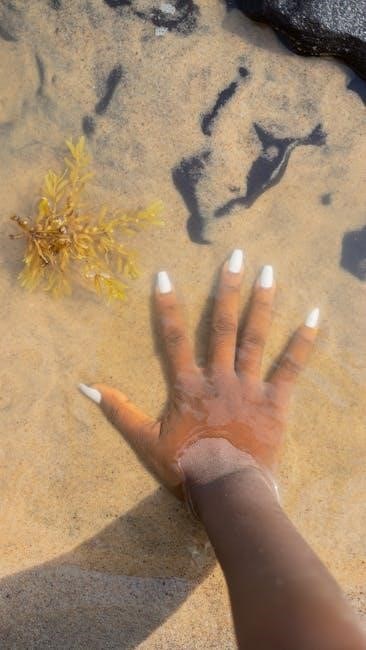
Safety Guidelines for Aquatic Therapy
Aquatic therapy requires careful safety guidelines‚ leveraging water’s buoyancy‚ viscosity‚ and hydrostatic pressure. Participants should consult healthcare providers‚ avoid overexertion‚ and ensure supervision by trained therapists.
6.1 Precautions Before Starting

Before beginning aquatic therapy‚ it’s essential to consult a healthcare provider‚ especially for those with medical conditions. Participants should disclose any health issues‚ such as heart problems or recent injuries‚ to ensure safe participation. A thorough medical clearance is often required to prevent complications. Additionally‚ proper warm-up exercises should be performed to prepare the body for water-based activities. It’s also crucial to avoid overexertion‚ as water can sometimes mask fatigue. Supervision by a trained therapist is highly recommended to monitor progress and prevent accidents. Proper hydration and comfortable swimwear are also important to ensure a safe and effective session.
6.2 Contraindications
Certain conditions may prevent individuals from participating in aquatic therapy. These include severe cardiovascular diseases‚ uncontrolled hypertension‚ or active infections‚ as water immersion can worsen these conditions. Open wounds or contagious skin infections are contraindications due to the risk of infection spread. Pregnant women with high-risk pregnancies or those experiencing early labor should avoid aquatic therapy. Additionally‚ individuals with severe respiratory issues‚ such as chronic obstructive pulmonary disease (COPD)‚ may find breathing difficult in water. Neurological conditions like unstable epilepsy or recent strokes also pose risks. Always consult a healthcare provider to assess suitability for aquatic therapy‚ as certain conditions may require specialized precautions or alternative treatments.
6.3 Importance of Supervision
Professional supervision is crucial during aquatic therapy to ensure safety and effectiveness. A trained therapist can monitor movements‚ prevent accidents‚ and adapt exercises to individual needs. Supervision helps maintain proper technique‚ reducing injury risks and enhancing therapeutic benefits. It also allows for real-time feedback and adjustments‚ ensuring exercises are performed correctly. For individuals with medical conditions‚ supervision is vital to manage health concerns and prevent complications. Additionally‚ a supervisor can motivate participants‚ track progress‚ and modify routines as needed. This personalized approach ensures a safe and effective experience‚ making supervision an essential component of aquatic therapy programs.

Creating an Aquatic Therapy Exercise Routine
Designing a personalized aquatic therapy routine involves tailoring exercises to individual needs‚ focusing on progression‚ and ensuring safety. Regular adjustments optimize results and maintain engagement.
7.1 Designing a Personalized Routine
Designing a personalized aquatic therapy routine begins with assessing individual needs‚ fitness level‚ and goals. A healthcare professional or therapist helps tailor exercises to address specific injuries‚ improve strength‚ or enhance flexibility. The routine should include a mix of aerobic‚ strength‚ and flexibility exercises‚ along with balance and coordination drills. Utilizing pool equipment like noodles or resistance devices can enhance workouts. Progression is key‚ starting with simple exercises and gradually increasing intensity. Regular practice ensures long-term benefits‚ with adjustments made as progress is observed. A well-structured routine promotes safety‚ engagement‚ and measurable results‚ making aquatic therapy an effective and enjoyable experience for participants of all fitness levels.
7.2 Progressing the Routine
Progressing an aquatic therapy routine involves gradually increasing intensity‚ duration‚ or resistance as the individual improves. This can be achieved by adding more complex exercises‚ increasing repetitions‚ or incorporating equipment like resistance bands or pool weights. For example‚ advancing from walking to high-knee jogging in the water or introducing deeper water exercises to enhance buoyancy challenges. The progression should align with the participant’s strength‚ flexibility‚ and endurance gains. Regular assessments by a therapist ensure safe and effective advancements. Setting clear‚ achievable goals helps maintain motivation and tracks improvements over time. Continuous progression keeps the routine engaging and maximizes therapeutic benefits‚ ensuring long-term success and adaptation to individual needs. Supervision is crucial to prevent overexertion and maintain proper form throughout the progression process.

Resources for Aquatic Therapy Exercises
Recommended PDF guides‚ such as those by OV Guseva‚ provide detailed aquatic exercise routines. Online references like wexnermedical.osu.edu and tutorials offer comprehensive resources for various aquatic therapy exercises.
8.1 Recommended PDF Guides
Several PDF guides‚ such as those by OV Guseva and АЛ Персиянова-Дуброва‚ provide comprehensive details on aquatic therapy exercises. These guides cover aerobic workouts‚ strength training‚ and flexibility routines. They are designed for various needs‚ including rehabilitation‚ chronic pain management‚ and sports performance. Many PDFs focus on specific conditions‚ like Parkinson’s disease or knee osteoarthritis‚ offering tailored exercises. Others emphasize techniques like Ai Chi‚ blending mental and physical practices. These resources are invaluable for therapists and individuals seeking structured aquatic therapy programs. They often include illustrations and step-by-step instructions‚ making them accessible for both professionals and patients. Downloading these guides ensures access to evidence-based exercises for optimal aquatic therapy benefits.
8.2 Online References and Tutorials
Online references and tutorials provide accessible and detailed insights into aquatic therapy exercises. Websites like wexnermedical.osu.edu offer downloadable PDFs and video guides‚ showcasing exercises such as the Forward Walk and Rotator Cuff exercises. These resources often include step-by-step instructions and visuals‚ making them ideal for both therapists and patients. Tutorials highlight the benefits of aquatic therapy for conditions like Parkinson’s disease and knee osteoarthritis. Many online platforms also feature tutorials on advanced techniques‚ such as Ai Chi‚ blending mental relaxation with physical movement. These resources are regularly updated‚ ensuring users access the latest methods and research. They serve as invaluable tools for designing personalized routines and progressing exercises safely and effectively.